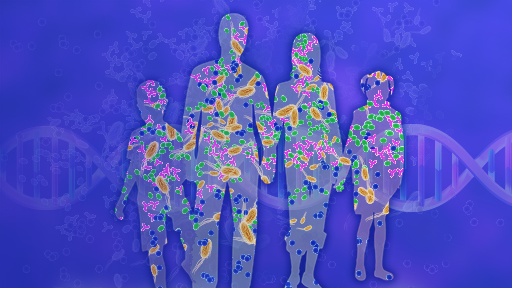Johnson R, Deming C, Conlan S, Zellmer CJ, Michelin AV, Lee-Lin SQ, Thomas PJ, Park M, NISC Comparative Sequencing Program, Weingarten RA, Less J, Dekker JP, Frank KM, Musser KA, McQuiston JR, Henderson DK, Lau AF, Palmore TN, Segre JA. Investigation of cluster of Sphingomonas koreensis infections. New England Journal of Medicine, 379(26):2529-2539. doi: 10.1056/NEJMoa1803238. 2018. [PubMed]
Tirosh O, Conlan S, Deming C, Lee-Lin SQ, Huang X, NISC Comparative Sequencing Program, Su HC, Freeman AF, Segre JA, and Kong HH. Expanded skin virome in DOCK8-deficient patients. Nature Medicine, 24(12):1815-1821. doi: 10.1038/s41591-018-0211-7. 2018. [PubMed]
Weingarten, RA, Johnson, RC, Conlan S, Ramsburg, AM, Dekker JP, Lau AF, Khil, P, Odom, RT, Deming C, Park M, Thomas PJ, NISC Comparative Sequencing Program, Henderson, DK, Palmore TN, Segre, JA, Frank KM. Genomic Analysis of Hospital Plumbing Reveals Diverse Reservoir of Bacterial Plasmids Conferring Carbapenem Resistance. MBio, 9(1). pii: e02011-17. 2018. [PubMed]
Byrd AL, Deming C, Cassidy, SKB, Harrison, OJ, Ng W-I, Conlan S, NISC Comparative Sequence Program, Belkaid, Y, Segre, JA, Kong HH. Staphylococcus aureus and S. epidermidis strain diversity underlying human atopic dermatitis. Science Translational Medicine, 9(397). pii: eaal4651. 2017. [PubMed]
Oh J, Byrd AL, Park, M, NISC Comparative Sequence Program, Kong HH, Segre, JA. Temporal stability of the human skin microbiome. Cell, 165(4): 854-866. 2016. [PubMed]
Conlan S, Park M, Deming C, Thomas PJ, Young AC, Coleman H, Sison C; NISC Comparative Sequencing Program, Weingarten RA, Lau AF, Dekker JP, Palmore TN, Frank KM, Segre, JA. Plasmid Dynamics in KPC-Positive Klebsiella pneumoniae during Long-Term Patient Colonization. MBio, 7(3) pii: e00742-16. 2016. [PubMed]
Naik S, Bouladoux N, Linehan JL, Han SJ, Harrison OJ, Wilhelm C, Conlan S, Himmelfarb S, Byrd AL, Deming C, Quinones M, Brenchley JM, Kong HH, Tussiwand R, Murphy KM, Merad M, Segre JA, Belkaid Y. Commensal-dendritic cell dialogue specifies unique skin immune signature. Nature, 520 (7545):104-8. 2015. [PubMed]
Belkaid Y, Segre JA. Dialogue between Skin Microbiota and Immunity. Science, 346(6212):954-9. 2014. [PubMed]
Oh J, Byrd AL, Deming C, Conlan S, NISC Comparative Sequence Program, Kong HH, Segre JA. Biogeography and individuality shape the functional divergence of the human skin metagenome. Nature, 514(7520):59-64. 2014. [PubMed].
Conlan S, Thomas PJ, Deming C, Park M, Lau AF, Dekker JP, Snitkin ES, Clark TA, Luong K, Song Y, Tsai YC, Boitano M, Dayal J, Brooks SY, Schmidt B, Young AC, Thomas JW, Bouffard GG, Blakesley RW; NISC Comparative Sequencing Program, Mullikin JC, Korlach J, Henderson DK, Frank KM, Palmore TN, Segre JA. Single molecule sequencing to track plasmid diversity of hospital-associated carbapenemase-producing Enterobacteriaceae, Science Translational Medicine, 6(254):254ra126. 2014. [PubMed]
Oh J, Freeman AF; NISC Comparative Sequencing Program, Park M, Sokolic R, Candotti F, Holland SM, Segre JA, Kong HH. The altered landscape of the human skin microbiome in patients with primary immunodeficiencies, Genome Res, 23(12):2103-14. 2013. [PubMed]
Findley K, Oh J, Yang J, Conlan S, Deming C, Meyer JA, Schoenfeld D, Nomicos E, Park M, NISC Comparative Sequencing Program, Kong HH, Segre JA (2013) Topographic diversity of fungal and bacterial communities in human skin. Nature, 498(7454):367-360. 2013. [PubMed]
Snitkin ES, Zelazny A, Gupta J, Palmore TN, Murray PR, Segre JA. Genomic insights into the fate of colistin resistance and Acinetobacter baumannii during patient treatment. Genome Res, 23(7):1155-62. 2013. [PubMed]
Yang JY, Brooks S, Meyer JA, Blakesley RR, Zelazny AM, Segre JA, Snitkin ES. Pan-PCR, a computational method for designing bacterial-typing assays based on whole genome sequence data. J Clin Microbiol, 51(3):752-8. 2013. [PubMed]
Oh J, Segre JA. Genomics: Resident risks. Nature, 490(7418):44-6. 2012. [PubMed]
Oh J, Conlan S, Polley E, Segre JA, Kong HH. Shifts in human skin and nares microbiota of healthy children and adults. Genome Med, 4(10):77. 2012. [PubMed]
Conlan S, Kong HH, Segre JA. Species-Level Analysis of DNA Sequence Data from the NIH Human Microbiome Project. PLoS One, 7(10):e47075. 2012. [PubMed]
Snitkin ES, Zelazny AM, Thomas PJ, Stock F; NISC Comparative Sequencing Program, Henderson DK, Palmore TN, Segre JA. Tracking a Hospital Outbreak of Carbapenem-Resistant Klebsiella pneumoniae with Whole-Genome Sequencing. Sci Transl Med, 4(148):148ra116. 2012. [PubMed]
Conlan S, Mijares LA, Comp Seq Program N, Becker J, Blakesley RR, Bouffard GG, Brooks S, Coleman HL, Gupta J, Gurson N, Park M, Schmidt B, Thomas PJ, Young A, Otto M, Kong HH, Murray PR, Segre JA. Staphylococcus epidermidis pan-genome sequence analysis reveals diversity of skin commensal and hospital infection-associated isolates. Genome Biol, 13(7):R64. 2012. [PubMed]
Naik S, Bouladoux N, Wilhelm C, Molloy MJ, Salcedo R, Kastenmuller W, Deming C, Quinones M, Koo L, Conlan S, Spencer S, Hall JA, Dzutsev A, Kong H, Campbell DJ, Trinchieri G, Segre JA, Belkaid Y. Compartmentalized Control of Skin Immunity by Resident Commensals. Science, 337(6098):1115-9. 2012. [PubMed]
Human Microbiome Project Consortium. Structure, function and diversity of the healthy human microbiome. Nature, 486(7402):207-14. 2012. [PubMed]
Grice EA, Segre JA. The Human Microbiome: Our Second Genome. Annu Rev Genomics Hum Genet, 13:151-70. 2012. [PubMed]
Kong HH, Oh J, Deming C, Conlan S, Grice EA, Beatson MA, Nomicos E, Polley EC, Komarow HD, NISC Comparative Sequence Program, Murray PR, Turner ML, Segre JA. Temporal shifts in the skin microbiome associated with disease flares and treatment in children with atopic dermatitis. Genome Res, 22(5):850-9. 2012. [PubMed]
Snitkin ES, Zelazny AM, Montero CI, Stock F, Mijares L; NISC Comparative Sequence Program, Murray PR, Segre JA. Proc Natl Acad Sci U S A, 108(33):13758-63. 2011. [PubMed]
Grice EA, Segre JA. The skin microbiome. Nat Rev Microbiol, 9(4):244-53. 2011. [PubMed]
Grice EA, Snitkin ES, Yockey LJ, Bermudez DM; NISC Comparative Sequencing Program, Liechty KW, Segre JA. Longitudinal shift in diabetic wound microbiota correlates with prolonged skin defense response. Proc Natl Acad Sci U S A, 107(33):14799-804. 2010. [PubMed]
Kong HH, Segre JA. Bridging the translational research gap: a successful partnership involving a physician and a basic scientist. J Invest Dermatol, 130(6):1478-80. 2010. [PubMed]
Grice EA, Kong HH, Conlan S, Deming CB, Davis J, Young AC; NISC Comparative Sequencing Program, Bouffard GG, Blakesley RW, Murray PR, Green ED, Turner ML, Segre JA. Topographical and temporal diversity of the human skin microbiome. Science, 324(5931):1190-2. 2009. [PubMed]
Grice EA, Kong HH, Renaud G, Young AC; NISC Comparative Sequencing Program, Bouffard GG, Blakesley RW, Wolfsberg TG, Turner ML, Segre JA. A diversity profile of the human skin microbiota. Genome Res, 18(7):1043-50. 2008. [PubMed]












